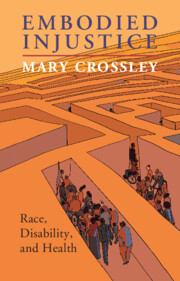Book contents
- Embodied Injustice
- Embodied Injustice
- Copyright page
- Dedication
- Contents
- Acknowledgments
- 1 Introduction
- 2 Health Disparities Based on Race and Disability
- 3 Biology’s (In)significance
- 4 Medical Mistrust
- 5 Maligned Mothers
- 6 Medicaid Preservation
- 7 Beyond Health Care
- 8 COVID Stories
- 9 The Busy, Troubled Intersection of Blackness and Disability
- 10 Conclusion
- Index
7 - Beyond Health Care
Social Determinants
Published online by Cambridge University Press: 18 August 2022
- Embodied Injustice
- Embodied Injustice
- Copyright page
- Dedication
- Contents
- Acknowledgments
- 1 Introduction
- 2 Health Disparities Based on Race and Disability
- 3 Biology’s (In)significance
- 4 Medical Mistrust
- 5 Maligned Mothers
- 6 Medicaid Preservation
- 7 Beyond Health Care
- 8 COVID Stories
- 9 The Busy, Troubled Intersection of Blackness and Disability
- 10 Conclusion
- Index
Summary
Previous chapters examined how medical providers and the health care financing system have contributed to health inequities that Black people and disabled people in the United States encounter. But having health insurance and getting to see an unbiased, high quality doctor are not necessarily the most important contributors to promoting health and health equity, either for individuals or at the population level. More important are other determinants of health. These include individual behaviors like smoking, diet, and exercise and –critically – the social and physical environments that shape individual conduct.1 To give one example: neighborhood safety and availability of parks or playgrounds nearby influence a person’s ability to exercise conveniently and safely. Healthy behavior takes some individual initiative, but that initiative is far more likely when social and physical environments make healthy options available and easy to choose.2
Keywords
- Type
- Chapter
- Information
- Embodied InjusticeRace, Disability, and Health, pp. 152 - 177Publisher: Cambridge University PressPrint publication year: 2022

